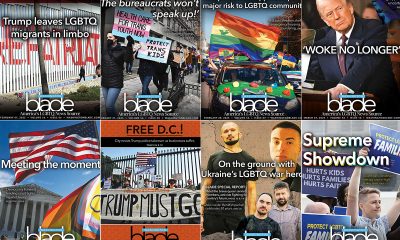Opinions
Veteran Blade features editor recalls all-time best and worst celeb interviews
From loquacious and chatty to boring and condescending, star subjects run gamut
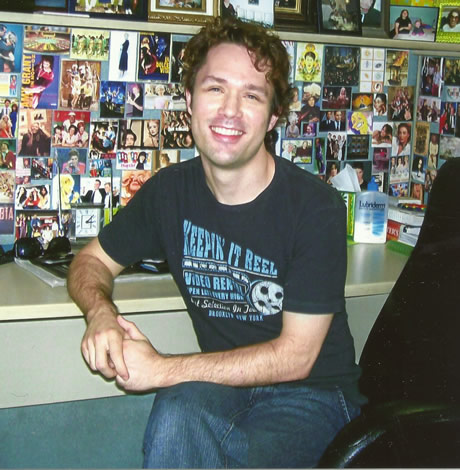

I’m naming names, so get ready.
I came to the Blade in October 2006 as news editor, then became features editor in 2008, which is my title to this day. That’s probably a record, but I have no easy way to verify that.
One small part of my job is interviewing celebrities. It’s tough when it’s somebody you’re not familiar with and you have to research from scratch. It’s super fun when it’s a star you’ve followed for a long time and can go deep and ask interesting, off-the-beaten-path stuff. I work hard to eschew the same handful of questions they’ve been asked nine zillion times before (e.g. to John Waters: “What was Divine like?”). You can geek out and go crazy deep/obscure for a few questions but obviously you don’t want an entire interview of that.
Often the audiences for these pieces are people who follow the subjects avidly already so you want to make it interesting for them as well as the casual fan. Nothing pisses off a fan base faster than a set of questions that sounds like you cobbled them together in 10 minutes after reading the press release and the Wikipedia page.
These are almost always done by phone because rarely is the celeb in D.C. prior to the event that’s bringing them to our region. I only agree to e-mail interviews under extremely rare circumstances because they usually cherry pick which questions they want to answer and there’s no chance to press them if they play coy or evasive. I let Larry Kramer by on a pass because he has severe hearing loss (he was great — we went several rounds of follow-up by e-mail) and Janis Ian, who was on vocal rest.
It’s tough when their handlers have scheduled back-to-back phoners and you only get 15 minutes and have to keep firing like you’re in the lightening round to cram in as much as possible. The celebs don’t give a shit — even under tight time constraints, you’ll sometimes get somebody who’ll ramble on for 10 minutes answering one question, so you’re fucked (I’m looking at you Megan Mullally). You also learn quickly, these people are never your friends; many of them are just good at giving you the temporary illusion that they’re chummy with you. As a mentor of mine used to say, you see how quickly that stops when the column inches are over.
It also sucks when their publicists stay on the line and cut you off just when you’re getting going. In some cases, I get it — some journalists would hog the celeb’s time so somebody has to be the bad cop. I’m greedy with my celeb time but never go crazy long. Thirty-40 minutes is ideal — you can actually breathe a little, give them time to ramble, then pick your most interesting responses to use. You always have to have more prepared than you’ll get to in case they go Bob Dylan on you and give one-word answers. The best situations are when you develop rapport, keep them engaged (typically this kind of thing bores them) and get them riffing way off their press release.
So after 11 years of doing this, I’m giving out my all-time best and worst awards for Blade interviews. We’ll start with the worst.
5. Stand-up legend Margaret Cho (“Mothers’ Day with Margaret” 2013; “Margaret goes ‘psyCHO’ on new tour,” 2015) — perfectly nice lady but not funny in interview mode; like, at all. Makes you feel like she’d rather be doing anything but this.
4. Actress Maria Bello (“Don’t label Maria Bello,” 2015) — didn’t have time for anything much once we got through talking about her book.
3. Andy Cohen (“Deep Talk with Andy Cohen,” 2017) — polite but just didn’t give me much to work with. Very succinct responses delivered in as few words as possible. It was like he couldn’t wait to get off the phone.
2. Singer Natalie Merchant (“Natalie Merchant goes deep,” 2017) — ostensibly polite and decent elaboration but sounded about as excited as a clerk at a D.C. 7-11.
1. Jazz pianist Patricia Barber (“Cerebral jazz,” 2013) — stock answers, kind of a tone of “why would you ask me that”? to every answer that made me feel she thought I was an idiot.
DISHONORABLE MENTION: Rufus Wainwright (“Rufus Wainwright on opera, revisiting his first two albums,” 2018) — Nice enough guy, but we were late getting started, then his handlers cut us off as if the clock had started at the time they were supposed to have called.
Best:
5. Actress Valerie Harper (“Taking on Tallulah,” 5-29-09) — one of the rare ones I got to do in person. Chatty, funny, willing to go anywhere the questions took her — a delight.
4. Singer/actress Patti LuPone (“Reminiscing with LuPone,” 9-8-11) — I was terrified. Miss LuPone does not suffer fools gladly and I’m not a show queen, so I was winging it slightly (but I had read her then-new memoir! You don’t always have time.). The appointed time came. Her husband answers and says sorry, she’s getting her hair done. She called a few hours later and apologized. It was perfect — that mild inconvenience put her more at my mercy, so she wasn’t prickly at all.
3. Figure skater/personality Adam Rippon (“Adam Rippon on new life, loves, memoir, ass and skating in the nude,” 2019) — candid, funny, balked at nothing, not in a hurry and genuinely sweet.
2. Motown legend Mary Wilson (“Mary Wilson shares Motown memories,” 2017) — the Supremes co-founder gleefully went anywhere I led and elaborated without prodding. Miss Ross, of course, has yet to deign us with her presence.
1. Actress Lily Tomlin (“Laughing with Lily,” 2014; “Lily Tomlin on why she’s happy she lost the Emmy this year — and a whole lot more,” 2018) — unsurprisingly, it’s often true that the bigger the name, the more you’re likely to encounter a diva. Tomlin, as many in my field would attest, is the exception. Exceedingly nice, the only celeb to ever make a point of using my name and never in a rush. The ultimate class act A-lister.
HONORABLE MENTIONS: Bruce Vilanch (“Dishing with Bruce,” 2013), Leslie Jordan (“Flamboyantly funny,” 2016; “Character actor Leslie Jordan on his pony obsession, TV hits and misses and dream threesome,” 2019); Salim Gauwloos (“Former Madonna dancer Slam recalls ‘Blond Ambition Tour,’ ‘Truth or Dare’); Dave Koz (“A Dave Koz Christmas,” 2014, “Koz and effect,” 2011), Yvonne Craig (“Holy spandex tights! It’s Batgirl!,” 2015) and Alison Arngrim (“Life on the ‘Prairie,’” 2011).
Opinions
Support the Blade as mainstream media bend the knee for Trump
From CBS to Washington Post, MAGA taking over messaging
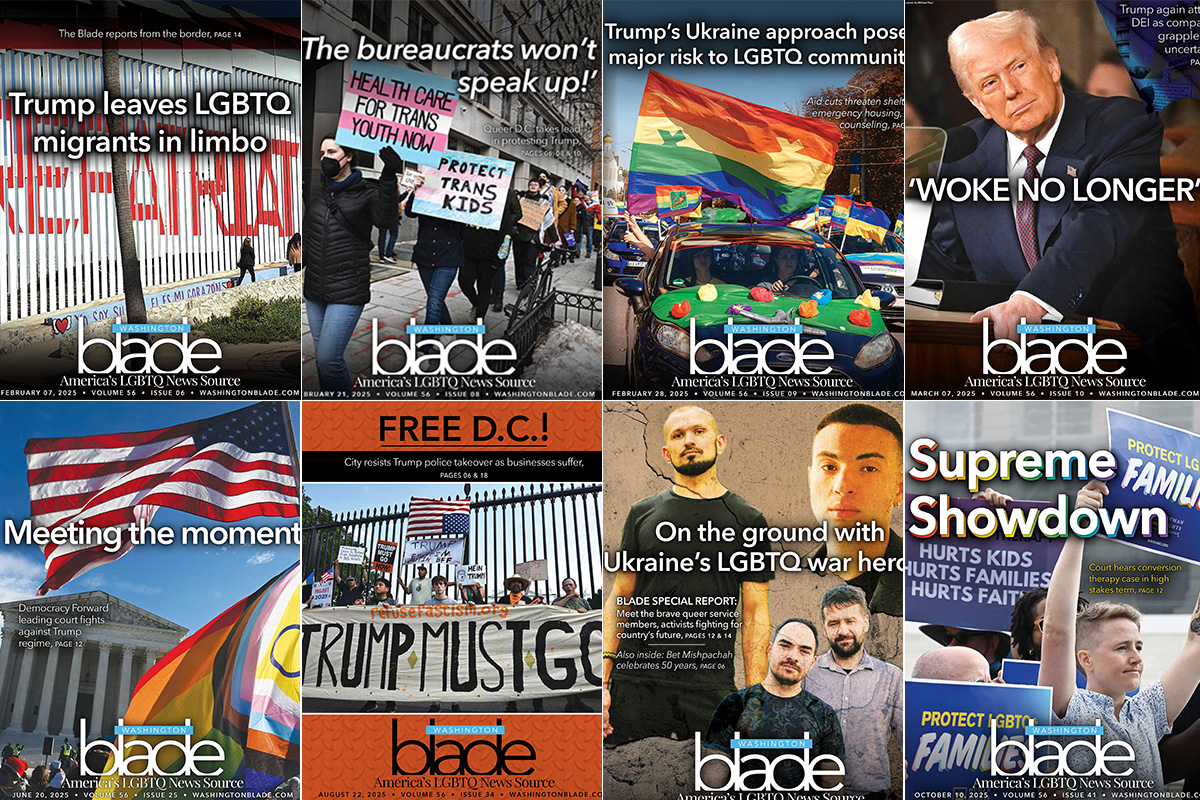
We knew it would be bad. I’m referring, of course, to 2025 and the unthinkable return of Donald Trump to the White House.
We just didn’t know how bad. The takeover of D.C. police. ICE raids and agents shooting defenseless citizens in the face. The cruel attacks on trans Americans. A compliant and complicit right-wing Supreme Court and GOP rubberstamping all the criminality and madness.
Much of that was outlined in Project 2025 and was predictable. But what has proven surprising is the speed with which major companies, powerful billionaires, and media conglomerates have hopped on board the authoritarian train and kissed Trump’s ring. Tech giants like Apple and Meta and media companies like CBS and the Washington Post have folded like cheap tents, caving to MAGA pressure and enabling Trump’s evil agenda.
The guardrails collapsed in 2025. Congress has ceded its role as a formerly co-equal branch of government. Once trusted media outlets have betrayed their audiences’ trust and morphed into propaganda arms of the White House. As a lifelong journalist, this is perhaps the most shocking and disappointing development of the past year.
The Washington Post, which adopted the ominous tagline of “Democracy Dies in Darkness,” killed its endorsement of Kamala Harris in the final days of the 2024 campaign. Same thing at the Los Angeles Times. More recently, CBS’s vaunted “60 Minutes” spiked a story critical of Trump’s immigration policies under the direction of new editor-in-chief Bari Weiss, a Trump toady and the antithesis of a journalist.
Concurrently, media companies large and small are fighting to survive. Government grants have been rescinded and the Corporation for Public Broadcasting, responsible for funding NPR and PBS, announced plans to dissolve. The Pittsburgh Post-Gazette, a nearly century-old Pulitzer Prize-winning institution, announced this week it will close on May 3. The Washington Post has lost scores of talented journalists, including prominent LGBTQ voices like Jonathan Capehart. The Baltimore Sun was acquired by the same family that owns right-wing Sinclair Broadcasting, ending a nearly 190-year tradition of award-winning, independent journalism.
It is not a coincidence that Trump’s attacks on democracy, traditions, and norms are happening while the media industry collapses. News deserts are everywhere now. In 2024, 127 newspapers closed, leaving 55 million Americans with limited or no access to local news, according to a report by Medill.
There’s a reason the media are called the “Fourth Estate.” Journalism was considered so critical to the health of our democracy that the Founding Fathers spelled it out in the First Amendment. Democracy and our Constitution cannot survive without a free and robust press.
That’s why I felt compelled to write this appeal directly to our readers. For nearly 57 years, the Blade has told the stories of LGBTQ Washington, documenting all the triumphs and heartbreaks and writing the first draft of our own history. Today, we remain hard at work, including inside the White House. This week, we have a reporter on the ground in Colombia, covering the stories of queer Venezuelan migrants amid the crisis there; another reporter will be inside the Supreme Court for next week’s trans-related cases; on Sunday, we have a reporter on the red carpet at the Golden Globes ready to interview the stars of “Heated Rivalry.”
We do a lot with a little. As major companies pull back on their support of the LGBTQ community, including their advertising in the Blade, we turn to our readers. We have never charged a dime to read the Blade in print or online. Our work remains a free and trusted resource. As we navigate these challenges, we ask that you join us. If you have the resources, please consider making a donation or purchasing a membership. If not, please subscribe to our free email newsletter. To join, visit washingtonblade.com and click on “Fund LGBTQ Journalism” in the top right navigation.
Our community is known for its resilience. At the Blade, we’ve weathered the AIDS epidemic, financial crises, and a global pandemic. We are committed to our mission and will never bend to a wannabe dictator the way so many mainstream media outlets have done. The queer press is still here and with your help we will survive these unprecedented attacks on democracy and emerge stronger than before. Thank you for reading the Blade and for considering making a donation to support our work.
Kevin Naff is editor of the Washington Blade. Reach him at [email protected].
Opinions
Time has run out for the regime in Venezuela
American forces seized Nicolás Maduro, wife on Jan. 3
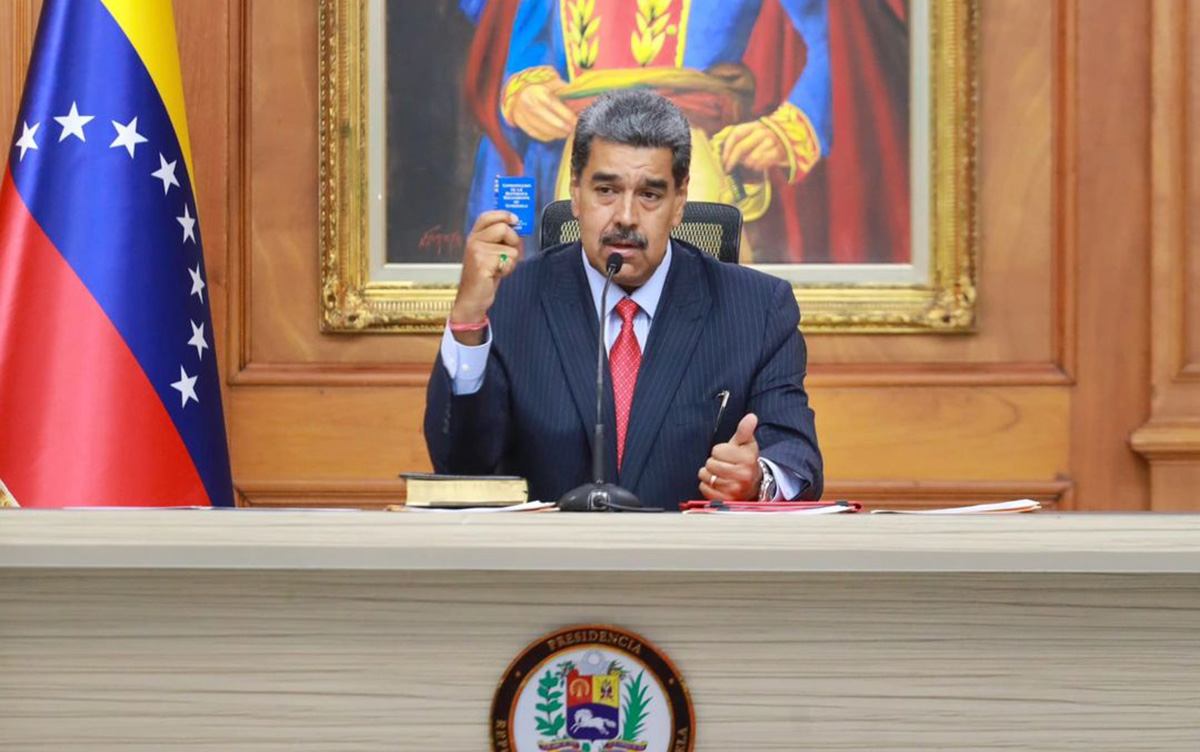
Time has run out for the regime in Venezuela.
I am fully aware that we are living through complex and critical days, not only for my country but also for the entire region. However, the capture of Nicolás Maduro has renewed hope and strengthened my conviction that we must remain firm in our cause, with the certainty that the valid reward will be to see Venezuela free from those who continue to cling illegitimately to power.
In light of this new reality, I adopt a clear, direct, and unequivocal position:
I demand the immediate release of all political prisoners.
I demand that all persons arbitrarily detained for political reasons be returned to their families immediately, without delay or conditions.
According to Foro Penal, as of Jan. 5, 2026, there are 806 political prisoners in Venezuela, including 105 women, 175 military personnel, and one adolescent, and a total of 18,623 arbitrary arrests documented since 2014. The same report documents 17 people who have died while in State custody and 875 civilians prosecuted before military courts, clearly evidencing the use of the judicial and security apparatus as instruments of political persecution. In parallel, the humanitarian system estimates that 7.9 million people in Venezuela require urgent assistance, further aggravating the impact of repression on daily life.
Behind these figures are shattered lives, separated families, and destroyed life projects. Students, activists, human rights defenders, political leaders, and members of the armed forces remain imprisoned without judicial guarantees, without due process, and without justice.
Since the capture of Nicolás Maduro, repression has not ceased. On the contrary, more than ten journalists have been arbitrarily detained, while others have been harassed, imprisoned, or mistreated for carrying out their duty to inform. Today, journalism in Venezuela has become a heroic and high-risk act.
This situation is further aggravated by a new attack on fundamental freedoms: an illegitimate decree of “external state of emergency”, whose purpose is to legalize state terrorism, expand the scope of repression, and deepen the criminalization of dissent and freedom of expression.
The destruction of freedoms cannot and must not be normalized, either by society or by the international community.
I do not forget the atrocities committed against people deprived of their liberty: systematic violations of due process, torture, cruel, inhuman, and degrading treatment, denial of medical care, and prolonged isolation.
These practices have been widely documented and denounced and are currently under investigation by international justice mechanisms.
In this regard, the United Nations Independent International Fact-Finding Mission on Venezuela has repeatedly expressed grave concern over the persistence of serious human rights violations, including the use of torture, enforced isolation, and the responsibility of State security forces in systematic abuses, as reflected in its statements and reports issued on Jan. 3, 2026, and throughout 2025.
From my unwavering commitment to human rights, I issue a firm and urgent call to Venezuelan citizens and to all people in the free and democratic world to stand together in defense of human dignity.
All political prisoners must be released now.
All torture and detention centers must be closed.
I am convinced that there can be no genuine democratic transition without the immediate release of political prisoners, the submission to justice of those responsible for arbitrary detentions, and the establishment of accountability mechanisms, guarantees of non-repetition, and full reparation for victims and their families. This is the only viable path toward a proper transition to democracy in Venezuela.
Today, more than ever, I stand in solidarity, inside and outside Venezuela, with the victims and their families.
This is a moment of definition, not of silence or hesitation.
I assume, together with millions of Venezuelans, that we are co-responsible for our collective reality and for the new Venezuela that we are called to rebuild.
Dignity, freedom, and justice cannot wait.
Freedom for Venezuela.
Juan Carlos Viloria Doria is president of the Global Alliance for Human Rights and vice president of Venezolanos en Barranquilla, an NGO based in Barranquilla, Colombia.
Opinions
Just say no to the felon in the White House
Democrats, media must do more to oppose Trump’s agenda
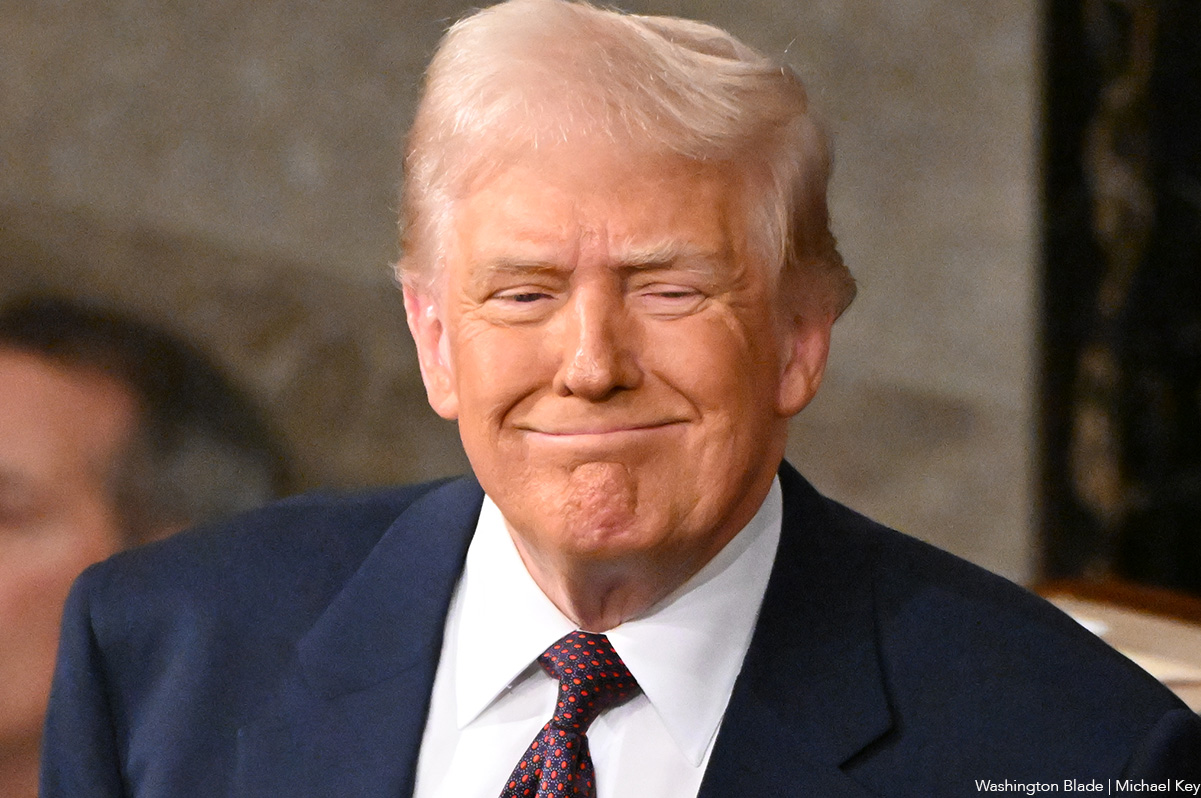
We have a clearly deranged, sick, felon as president, who can’t even remember if he had an MRI, or a CT. He says he takes enough aspirin to keep his blood running thin in his veins. He fakes health reports, and lies every time he opens his mouth. His brain appears foggier than Joe Biden’s ever was.
The felon arranged to get a fake Peace Prize from the soccer federation, while taking military actions around the world. He sanctioned American attacks on Nigeria, Iran, Syria, and now on the government, and people, of Venezuela. He has our military attacking boats, claiming they are carrying drugs, with no proof. He interferes in foreign elections, making the United States less safe. He obviously supports Putin in his war against Ukraine, and supports Netanyahu’s destruction of Gaza, and his starvation of the Palestinian people there. Because of all this it’s understandable why he calls his Secretary of Defense, his Secretary of War. That individual being unqualified with no competence, or decency — the perfect toady for the fascists surrounding Trump. He has a Secretary of State in Marco Rubio who clearly has no principles at all. Rubio previously said, “Donald Trump – a con artist – will never get control of this party…We cannot allow a con artist to get access to the nuclear codes of the United States of America.” He compared Trump to a “third-world strong man.” Now as Secretary of State he justifies all the illegal actions the felon takes.
I, and many others, question “Where is Congress in all this?” Do no Republicans in Congress have any cojones? Two Republican woman have criticized Trump — Marjorie Taylor Greene (R-Ga.) and Nancy Mace (R-S.C.). Both on the Epstein files, one on screwing the American people with regard to their health insurance. Both are now out of Congress, still MAGA, but found if you disagree with the felon, he sics his cult on you.
My other question is: When will any in the media really stand up to him? When do mainstream media call out every one of his lies, as he makes them? When do they show any guts, and repeat each day he is deranged? When do they have daily headlines, calling him out on things from his health reports, to lies about the economy? Where are the daily headlines calling out the Republican Congress for its lack of action? Why is there no representative clock on every TV network, ticking off the time Congress doesn’t take back their rightful place as an equal branch of government? When will they call out the Supreme Court, reminding people what Trump’s picks said during their confirmations, versus what they are doing now? When will they actually reclaim ‘The freedom of the press?’
Democrats must continue to speak out. I am aware they have little power in this Congress, but they must not remain silent. We have seen, when they do speak up, we win elections. They help the people to wake up, as they did in recent elections in New Jersey and Virginia. In races as distinct as the mayoralty of Miami, where a Democrat won for the first time in 30 years, and did so in a landslide; and Democrats won two special elections for State Senate in Mississippi. In Georgia, Democrats won two seats on the Georgia Public Service Commission, the first time in 20 years they won a statewide seat. And they won a State Senate seat in Iowa, and the redistricting vote in California.
To continue winning Democrats must remind people every day what the felon, and his fascist cohorts, are doing to destroy their lives. Latinos and Hispanics need a daily reminder, it is the felon who once said he supports them, whose government is now deporting them. Young people must be reminded every day, the felon is destroying the country they will inherit, their future, by denying climate change. Everyone needs daily reminders how he is destroying the health of the country. Ending research grants looking for cures for cancer, Alzheimer’s, Parkinson’s, and HIV/AIDS. Ending research grants into curing childhood diseases, development of mRNA vaccines, and other potential progress to protect Americans, and the world, when the next pandemic occurs, and it will. He is literally killing children by having his government speak out against vaccinations for illnesses like measles, considered eradicated before he came into office.
All of this needs to be headlined each day in our newspapers, and on TV, by the people who still can, and are willing, to do it. Those not bought off by, or afraid of, the felon, and his fascist cohorts. Those who don’t sit with him at Mar-a-Lago, and have become his enablers. We the people need to take to the streets and every time there is an election, use our vote to say to the sick, deranged, felon, and his fascist cohorts, ‘NO MORE’.
Peter Rosenstein is a longtime LGBTQ rights and Democratic Party activist.
-

 National4 days ago
National4 days agoWhat to watch for in 2026: midterms, Supreme Court, and more
-

 District of Columbia5 days ago
District of Columbia5 days agoTwo pioneering gay journalists to speak at Thursday event
-

 a&e features5 days ago
a&e features5 days agoQueer highlights of the 2026 Critics Choice Awards: Aunt Gladys, that ‘Heated Rivalry’ shoutout and more
-

 Colombia4 days ago
Colombia4 days agoBlade travels to Colombia after U.S. forces seize Maduro in Venezuela

